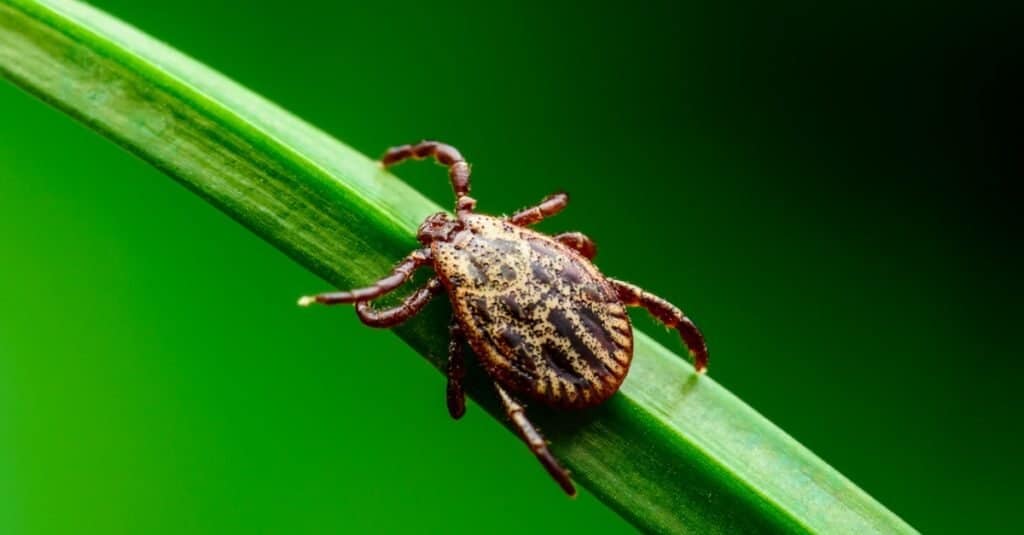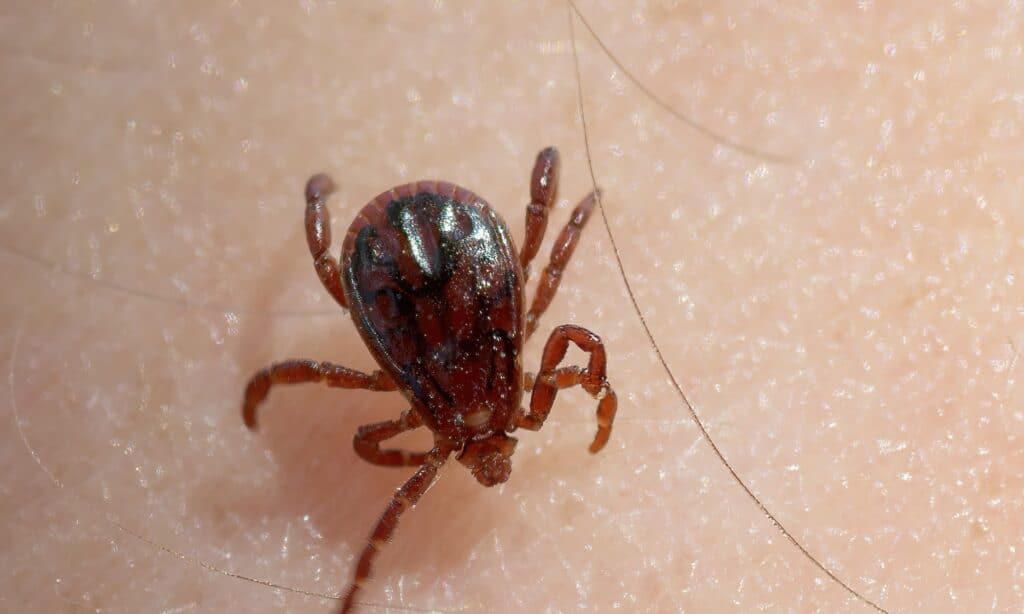There are ticks in South Carolina, just like every other state in the United States. Ticks live on every continent on Earth, including Antarctica. But, their favorite conditions are those that are warm and humid, making South Carolina the perfect home for ticks. Fortunately for residents of this southern state though, incidences of disease and infection from ticks are low. There are over 900 species of tick in the world, but only four of those are found in South Carolina.
Here, we’ll learn whether or not you need to be worried about catching Lyme disease from the ticks in South Carolina. Then, we’ll learn how to identify each of the four species of ticks found in the state. Finally, we’ll learn what steps to take to avoid ticks in South Carolina, and what to do if one happens to bite you, or your dog.
The Ticks of South Carolina
Let’s take a look at the four species of ticks you might run into in South Carolina.
1. American Dog Tick

One of the most common ticks in North America, the American dog tick lives primarily in open grasslands.
©iStock.com/nechaev-kon
American dog ticks in South Carolina start out small, but they can grow up to 10x their original size when fully fed. These ticks have red-brown bodies with small mouthparts and red-brown legs. Males have mottled tan and brown abdomens, while females have brown abdomens with tan scuta. The scuta are the small, round shields just behind their heads.
American dog ticks are the primary vector for Rocky Mountain spotted fever. They are also called wood ticks and can be found along the entire eastern seaboard. They frequently feed on humans, dogs, rabbits, coyotes, raccoons, and other mammals. American dog ticks are most active in the spring and summer months.
2. Gulf Coast Tick

Found predominantly along the coasts, Gulf Coast ticks live in many of the same habitats as American dog ticks.
©iStock.com/cturtletrax
Gulf Coast ticks in South Carolina are small, with red-brown bodies and light brown legs. Their mouthparts are significantly bigger than those of the American dog tick, while the Gulf Coast tick overall is much smaller. Males have some tan mottling on their abdomens, while females have light tan scuta. Gulf Coast ticks do not transmit Lyme disease.
Gulf Coast ticks are only found in the southeastern United States. They feed on everything from birds and rodents, to coyotes, bears, skunks, humans, and dogs. They’re most active in the spring and summer months. Young Gulf Coast ticks particularly like the blood of birds, like the quail, bunting, and meadowlark. They also feed on cattle, pigs, horses, and white-tailed deer.
3. Lone Star Tick

Widespread throughout the state, Lone star ticks are common.
©iStock.com/epantha
Lone star ticks in South Carolina are extremely common and widespread throughout the entire state. They have brown bodies with very large mouthparts. Only females bear the distinctive ‘lone star’ marking in the middle of their back. Males have only some dark mottling.
Lone star ticks are also known as turkey ticks, cricket ticks, and northeastern water ticks. They’re predominantly found in the eastern United States and Mexico. Because they have such long mouthparts, bites from these ticks can easily become infected. Lone star ticks do not transmit Lyme disease, but they do carry human monocytic ehrlichiosis.
4. Brown Dog Tick

These ticks have colonized manmade structures so successfully that they’re even present in Antarctica.
©iStock.com/RobertAx
Brown dog ticks have slender, brown bodies with brown legs. Males and females are almost indistinguishable; both have small mouthparts. The most unique feature of the brown dog tick is where it chooses to live: indoors. There are no other ticks in South Carolina that make their home in manmade structures.
Brown dog ticks feed off of dogs to the exclusion of just about every other creature. Occasionally, they will bite humans or even cats, but these incidences are rare. They’re most often found in areas near dogs, like dog beds, crates, or kennels. Brown dog ticks do not transmit Lyme disease but do carry canine diseases.
Do Ticks in South Carolina have Lyme Disease?
In North America, the only tick that carries Lyme disease is the deer tick, also known as the black-legged tick. Deer ticks get the pathogen as larvae or nymphs when they feed on mice that carry it. While the deer ticks do not suffer from the pathogen, they may pass it on to humans through their bite. Since there are no deer ticks in South Carolina, there are very few incidences of the disease in the state. Lyme disease is much more common in northeastern states, like Rhode Island and Pennsylvania.
How to Avoid Ticks in South Carolina
Ticks may not be insects, but you take many of the same steps in avoiding them. First, wear light-colored, long-sleeved shirts and long pants. Ticks can’t bite through clothing, so putting a barrier between them and your skin is key. You can also spray your clothes (never your skin) with insect repellant. Repellants that contain permethrin are particularly effective against ticks. Finally, stay out of areas with thick undergrowth, as these are hotbeds for ticks.
What to Do if a Tick Bites You in South Carolina

Tick bites in South Carolina can be scary, but they’re relatively harmless.
©Afanasiev Andrii/Shutterstock.com
If you find a tick embedded in your skin, you need to remove it as soon as possible. You don’t need fancy tick removal tools or a trip to the hospital. Because ticks transmit illness through their saliva, the faster you can get it out, the better. Use tweezers to grasp the tick as close to the skin as possible, then firmly pull it out. Clean the area with antiseptic wipes, and monitor for rashes or other unusual symptoms in the month following the bite.
The photo featured at the top of this post is © 7th Son Studio/Shutterstock.com
Thank you for reading! Have some feedback for us? Contact the AZ Animals editorial team.







